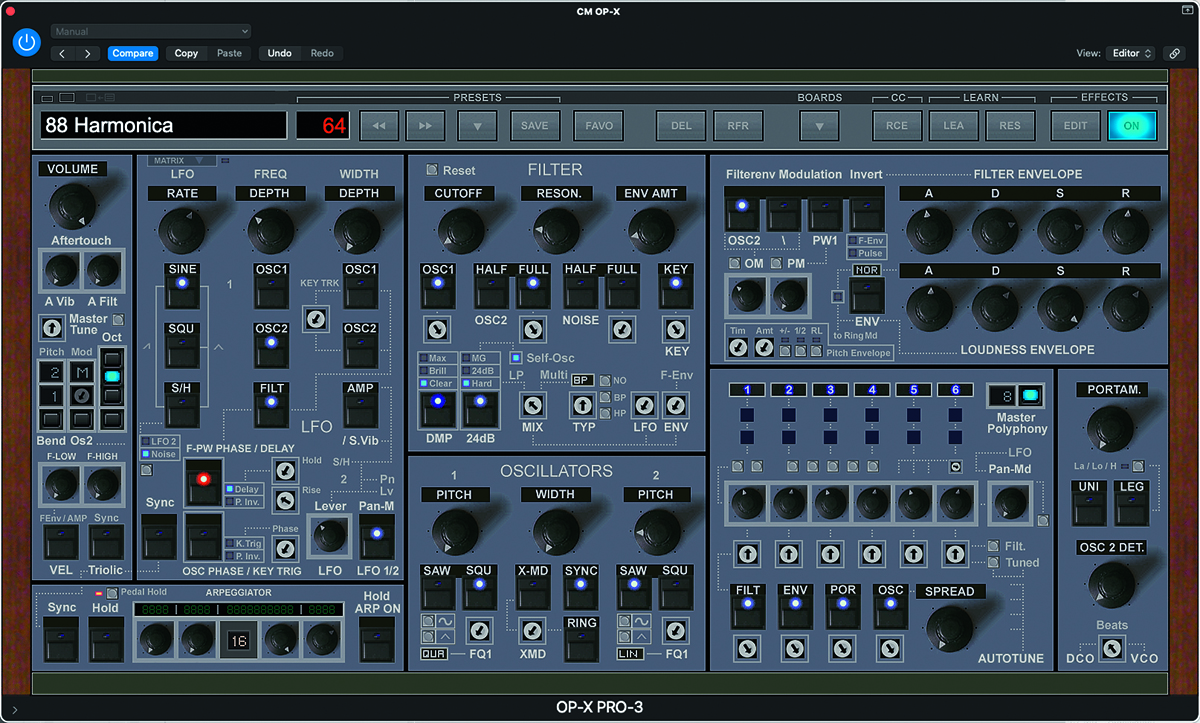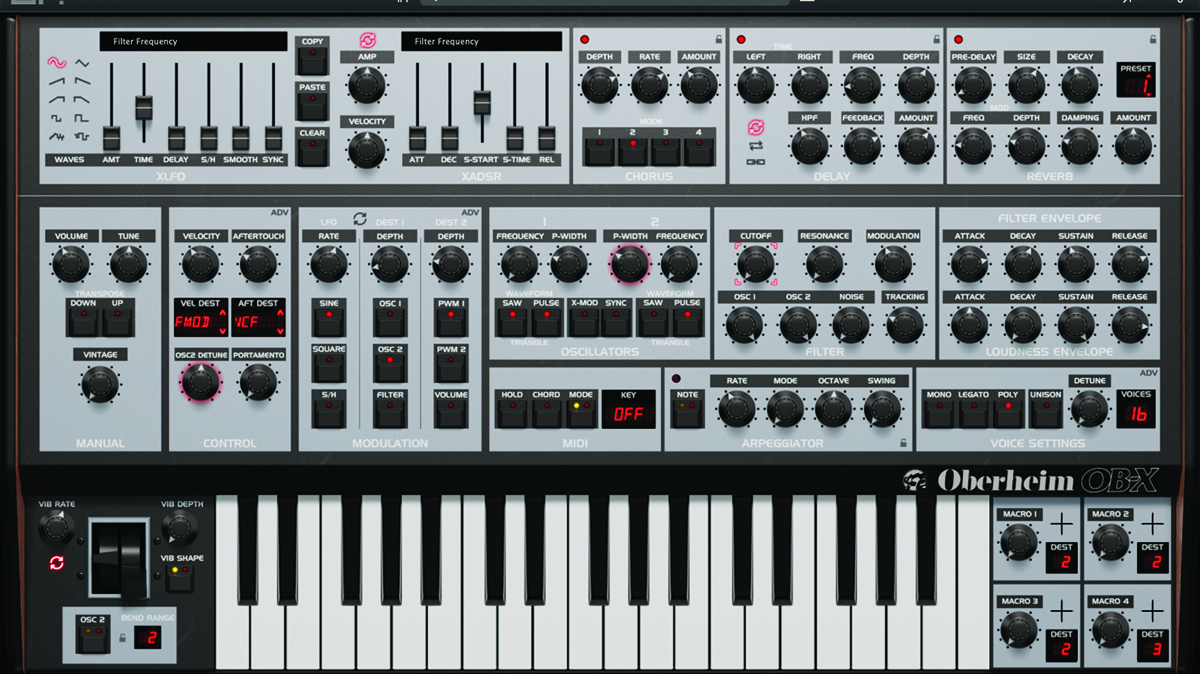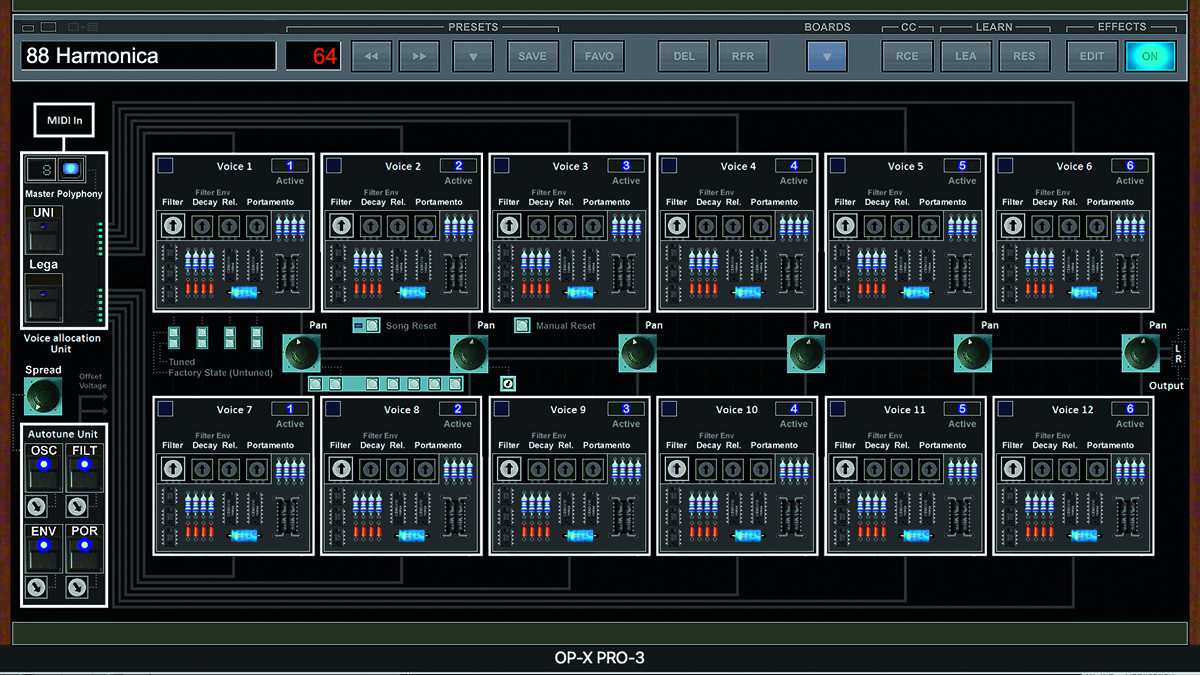MusicRadar Verdict
While the OP-X PRO-3 clearly started life as a software clone, it extends way beyond the concept, while keeping impressive detail and depth of sound.
Pros
- +
Superb reimagining of an Oberheim synthesizer.
- +
Deep-diving to the voice board level is just genius!
- +
It’s packed with thousands of patches.
Cons
- -
The operational elements of the OP-X will take a little getting used to.
MusicRadar's got your back
SonicProjects OP-X PRO-3: What is it?
One company from the vintage era which seems to be getting quite a bit of attention lately is Oberheim. Renowned for its groundbreaking Synthesizer Expander Module (SEM), and ’80s polysynths, its name became associated with huge-sounding synthesisers, wide pads, deep basses and sync-based leads.
This is ripe territory for any soft-synth designer. One such design house, SonicProjects, has been beavering away with its OP-X synth Oberheim clone for some time, which is now in its Mk3 phase. Even the name bears reverence to Oberheim, but how far does this extend? Well, quite some considerable margin, in both sound and architecture, but let’s start with the basic concept.
The PRO-3 version of the OP-X is a 12-voice synth, available in only VST3 and AU formats. Its sharp GUI ships in a default ‘beige’, with two additional skins available for download, labelled as Dark and Blue. The latter could easily be associated with the OB colour scheme, and according to SonicProjects, it is the most requested skin in the pack.

SonicProjects OP-X PRO-3: Performance and verdict
The signal construct begins with two oscillators per voice, although the extent you can dive within each individual voice is considerable. Inspired by the OB Matrix-12, the OP-X allows access to virtual voice boards, at which stage you can control individual parameters, such as tuning calibration and panning of each voice. Just like its analogue counterpart, notes cycle through the voice boards in sequence. This means that any settings will be repeated upon each re-triggering of a voice, which can be superb if used in a sequence or pattern of notes.

• GForce Software OB-X
GForce is always fastidious about detail, and its incarnation of the OB-X is another worthy clone.
• Cherry Audio Eight-Voice
Based around the OB 8-Voice, Cherry Audio’s impressive plugin creates thunderous tones.
You can switch the OP-X into poly-modes of six, eight and 12 voices, as well as Mono/Legato and Unison modes; the latter being a floor-shaker thanks to voice stacking and detuning.
The extensive nature of the filter section adds colour to the melée. There are 10 different filter types onboard, although exploration of these iterations extends exponentially beyond this figure. At the more simplistic end, OP-X offers both OB-style filters at 12dB and 24dB, and a Moog-style ladder filter, fixed at 24dB. These two are perfect companions, as the OB filter maintains lower-end structure integrity, against the Moog ladder, should you push the resonance. However, the OP-X also includes a SEM-style filter, with all of its complexities in low, high, band and notch-pass filtering, and all controlled across the stereo field for added depth and detailing.
The traditional construct continues to the envelope section, where dedicated envelopes for amplitude and filter adopt the familiar ADSR layout. The LFO section also displays Oberheim familiarity, with immediate routings to the more obvious destinations, such as oscillator pitch and PWM. If you want to go further, a dropdown reveals a modulation matrix, inviting selection of source and destination, allowing the routing of pretty much anything to anything!
Want all the hottest music and gear news, reviews, deals, features and more, direct to your inbox? Sign up here.

Arps to MIDI control
It becomes very apparent, from the moment you begin to play around with the OP-X PRO-3, that it makes no bones of its analogue stylings, while staying within the digital domain for a perfect level of convenience. Thanks to the voice board options, you become very aware of detuning; it’s subtle at first, but with the ability to really push the natural and analog-istic detuning envelope if required, and with the instant ability to rein it in, should it become too unwieldy.
Further control is available via the MIDI Learn function, but we also found ourselves getting lost in the Arpeggiator section, which provides an extensive array of 32 modes. We also found that while the GUI isn’t hugely flexible in its ability to resize, it does offer two window sizes, with the smaller version being perfect for laptop working, and the larger size looking great on the larger screen in the CM studio. In its larger format, it definitely made the editing process more pleasurable.
Getting patched
So, why consider buying a reimagining of an Oberheim, such as this? In the case of the OP-X PRO-3, you get far more than what you might call an analogue-styled sum-of-parts. It really does sound impressive! There is a weight and depth to the sound, which is sonically a cut above, as well as being incredibly authoritative.
Building user patches becomes an enormously pleasurable pursuit
The detail in the bottom end is sublime, while the high/mids can sound beautifully wispy, according to your filter preference. The OP-X also extends the OB remit, with lots of additional niceties.
Packed with a staggering 3,500 patches, you can very quickly get an idea of its sonic character and capabilities, and while the interface will take a little bit of getting used to (much like an Oberheim), building user patches becomes an enormously pleasurable pursuit.
MusicRadar verdict: While the OP-X PRO-3 clearly started life as a software clone, it extends way beyond the concept, while keeping impressive detail and depth of sound.
SonicProjects OP-X PRO-3: Hands-on demos
SonicProjects
Vince Xmetric
VST's Sounds
SonicProjects OP-X PRO-3: Specifications
- Minimum macOS 10.15 / Ventura supported. AU or VST3 host. M1 silicon natively supported.
- Minimum Windows 10 / Windows 11 supported. 64-bit host supporting VST3.
- CONTACT: SonicProjects
Roland Schmidt is a professional programmer, sound designer and producer, who has worked in collaboration with a number of successful production teams over the last 25 years. He can also be found delivering regular and key-note lectures on the use of hardware/software synthesisers and production, at various higher educational institutions throughout the UK




